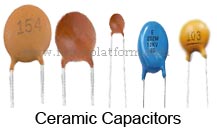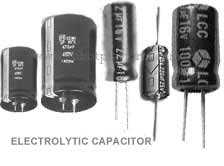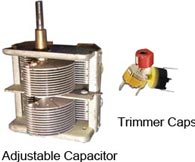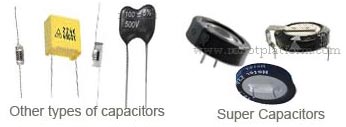Types of Capacitors
There are different capacitors available in the market. Here we will broadly classify them based on their characteristics and applications. The surface area of plates and material used as a dielectric differentiates them between each. Larger plate area with smaller area between the plates leads to larger capacitance. Material used in the dielectric also affects capacitance. As hobbyists, let us consider few of those capacitors which we use in our circuits.
Ceramic Capacitor:
 Ceramic capacitors are non-polarized (i.e. there is no marking as positive or negative. You can connect the leads any way) capacitors usually made of materials like titanium acid barium, or any ceramic material that acts a dielectric between metal plates. These disc shaped small Ceramic capacitors are stable to temperate, voltage and frequency, but have very low capacitance. There are also multi layered variants available that has multi layer dielectric. Ceramic capacitors are especially good for high frequency circuits.
Ceramic capacitors are non-polarized (i.e. there is no marking as positive or negative. You can connect the leads any way) capacitors usually made of materials like titanium acid barium, or any ceramic material that acts a dielectric between metal plates. These disc shaped small Ceramic capacitors are stable to temperate, voltage and frequency, but have very low capacitance. There are also multi layered variants available that has multi layer dielectric. Ceramic capacitors are especially good for high frequency circuits.
Electrolytic Capacitor:
The most commonly used capacitor in any circuit boards is the Electrolytic capacitor. One of the conducting plates will be metal (aluminum mostly) and the other conducting surface being an Electrolytic (Chemical compound) Dielectric deployed will be a thin film of metal oxide.  These are polarized capacitors with highest capacitance and cannot be used in AC circuits. A typical Electrolytic capacitor has two leads where one lead is longer (denoting +ve) than the other. If you observe carefully, some Electrolytic capacitors also have a thin black strip going further the lead to end of the capacitor indicating negative lead. (Although there are non-polarized versions available, we rarely use them in our robot circuits) Unlike Ceramic capacitors, Electrolytic capacitors tend to break and burn a lot. Poor tolerance and lower temperature range, leakage, low voltage breakdown and many other facts make them unfriendly for high frequency circuits. But their cheap cost, ideal for energy storage makes them most sought out component in any electronic circuit. If you are using one, make it a point to use an Electrolytic capacitor whose value is at least twice as much as the supply voltage. If you are to use 6 volts as your supply voltage, make use of a capacitor which is at least 12 Volts or 15 volts. If you ignore my words and send a higher voltage to a lower rated capacitor, then be ready to hear a burst (At least to see white smoke).
These are polarized capacitors with highest capacitance and cannot be used in AC circuits. A typical Electrolytic capacitor has two leads where one lead is longer (denoting +ve) than the other. If you observe carefully, some Electrolytic capacitors also have a thin black strip going further the lead to end of the capacitor indicating negative lead. (Although there are non-polarized versions available, we rarely use them in our robot circuits) Unlike Ceramic capacitors, Electrolytic capacitors tend to break and burn a lot. Poor tolerance and lower temperature range, leakage, low voltage breakdown and many other facts make them unfriendly for high frequency circuits. But their cheap cost, ideal for energy storage makes them most sought out component in any electronic circuit. If you are using one, make it a point to use an Electrolytic capacitor whose value is at least twice as much as the supply voltage. If you are to use 6 volts as your supply voltage, make use of a capacitor which is at least 12 Volts or 15 volts. If you ignore my words and send a higher voltage to a lower rated capacitor, then be ready to hear a burst (At least to see white smoke).
Adjustable Capacitor:
 As the name suggests, adjustable capacitor, or variable capacitors gives you the comfort of adjusting the capacitance. If you have ever opened a radio, you can find a variable capacitor used to tune stations. Most common Adjust capacitor contains a rotor and metal plates arranged over it with gaps between them. Capacitance can be adjusted by varying the distance between metallic plates, or surface are of metallic plates using the rotor. A smaller version of variable capacitor known as trimmer capacitor is also available which can be directly inserted into circuit and soldered across. Capacitance can be varied by adjusting a screw mounted over this trimmer using a screwdriver or a similar tool.
As the name suggests, adjustable capacitor, or variable capacitors gives you the comfort of adjusting the capacitance. If you have ever opened a radio, you can find a variable capacitor used to tune stations. Most common Adjust capacitor contains a rotor and metal plates arranged over it with gaps between them. Capacitance can be adjusted by varying the distance between metallic plates, or surface are of metallic plates using the rotor. A smaller version of variable capacitor known as trimmer capacitor is also available which can be directly inserted into circuit and soldered across. Capacitance can be varied by adjusting a screw mounted over this trimmer using a screwdriver or a similar tool.

Other types of capacitors:
There are many other types of capacitors made of polystyrene, mica, polypropylene, etc. Also available are super capacitors with huge capacitance and a relatively small dimension.
Capacitor representation:
In any circuit diagram, Capacitors are generally represented by two vertical lines and a horizontal line perpendicular to them going away from each other as shown in below image.

An adjustable capacitor is shown just like a non-polarized capacitor with an arrow across the capacitor symbol. Lastly, Trimmers capacitors are symbolized similar to an adjustable capacitor, but with a T like symbol across rather than an arrow as in adjustable capacitor.
Tutorial index:
Do you have anything to say?
Visit the Forum to discuss, learn and share anything related to robotics and electronics !!








